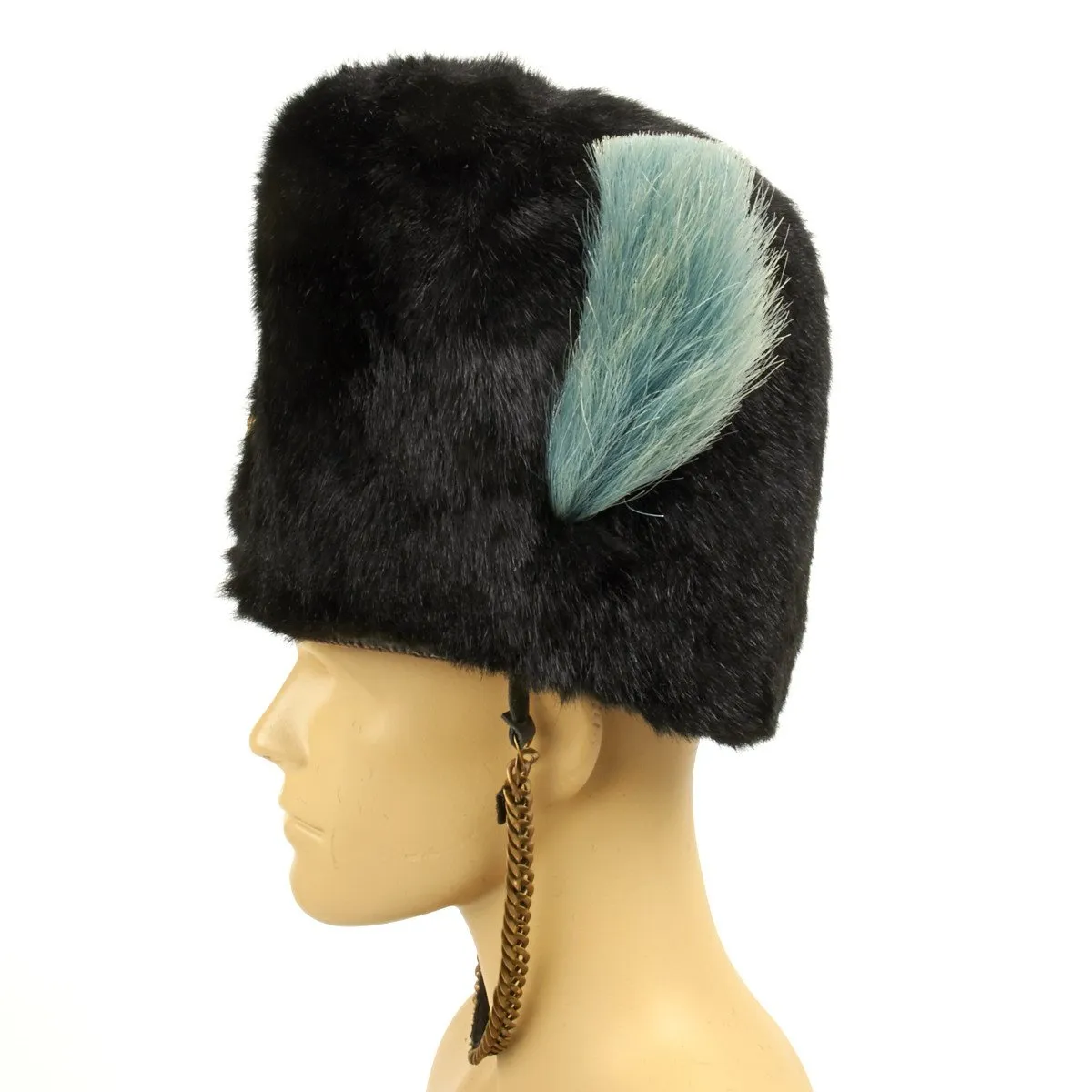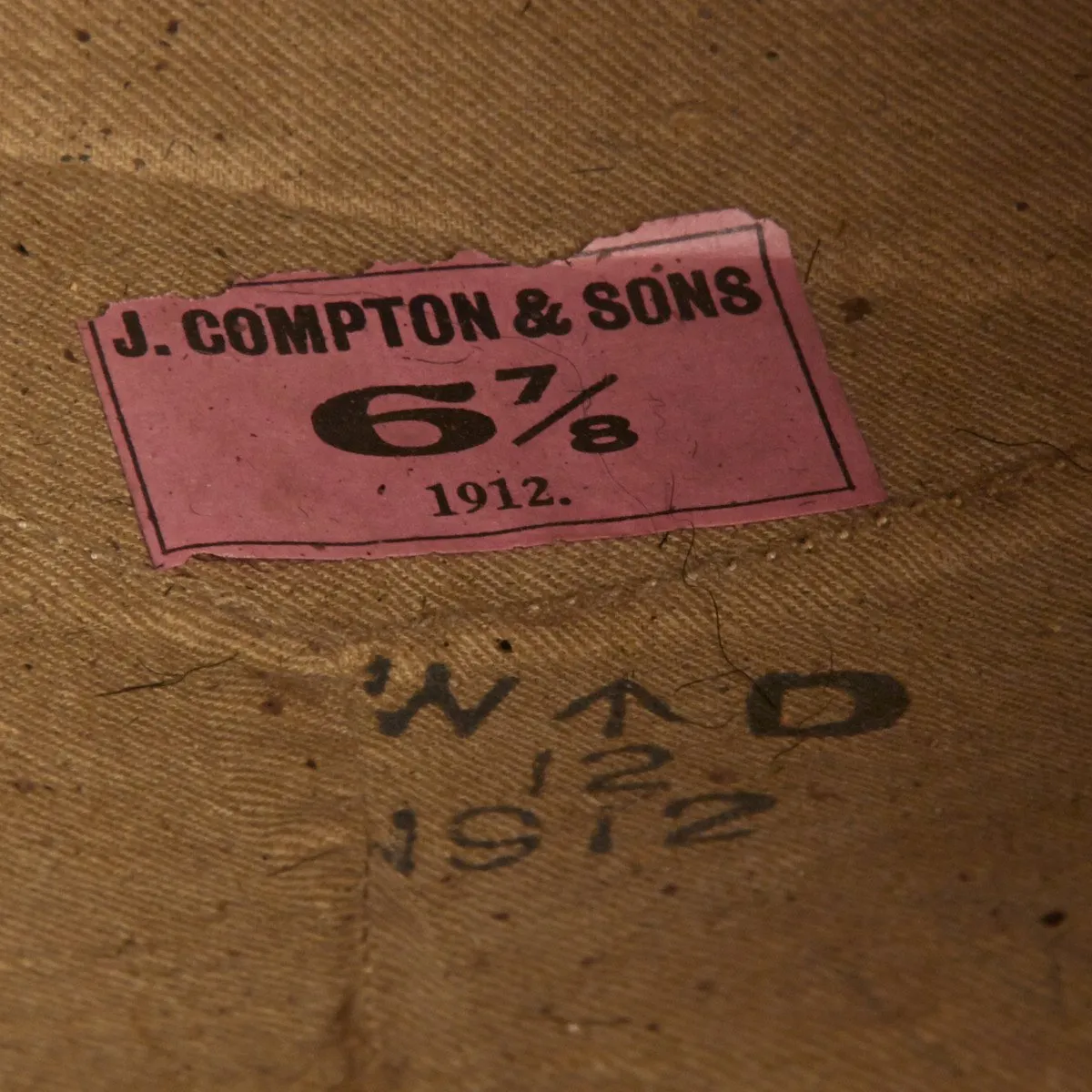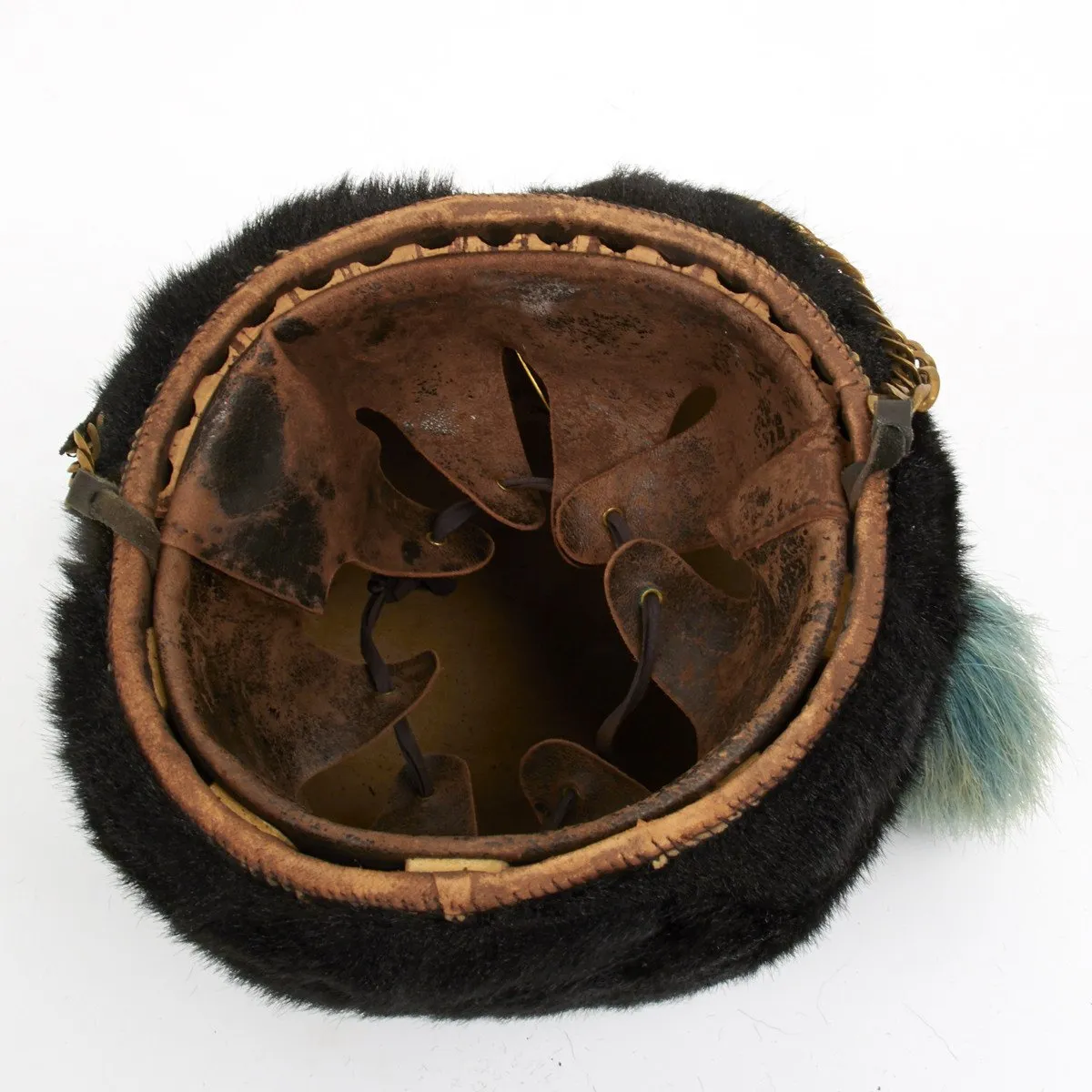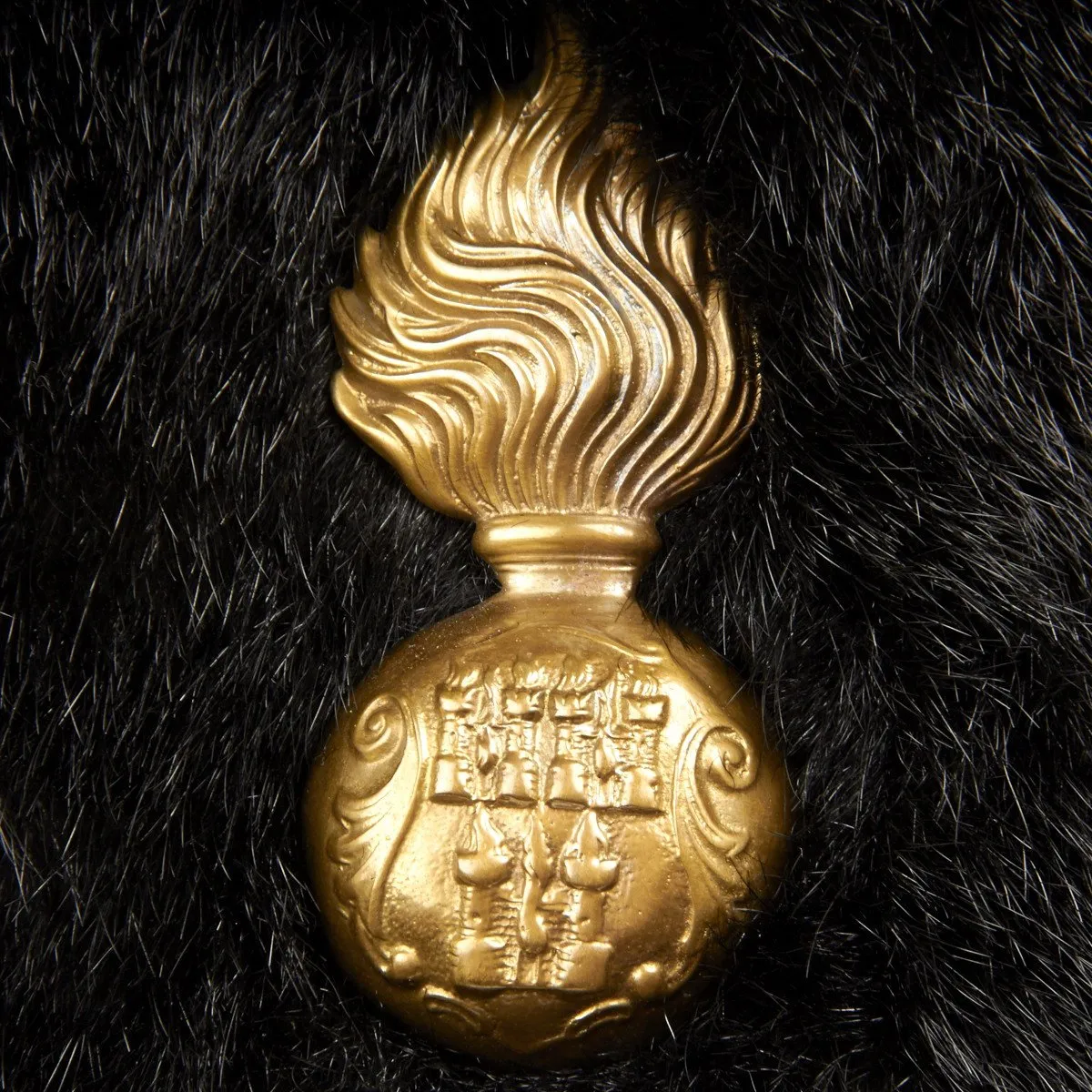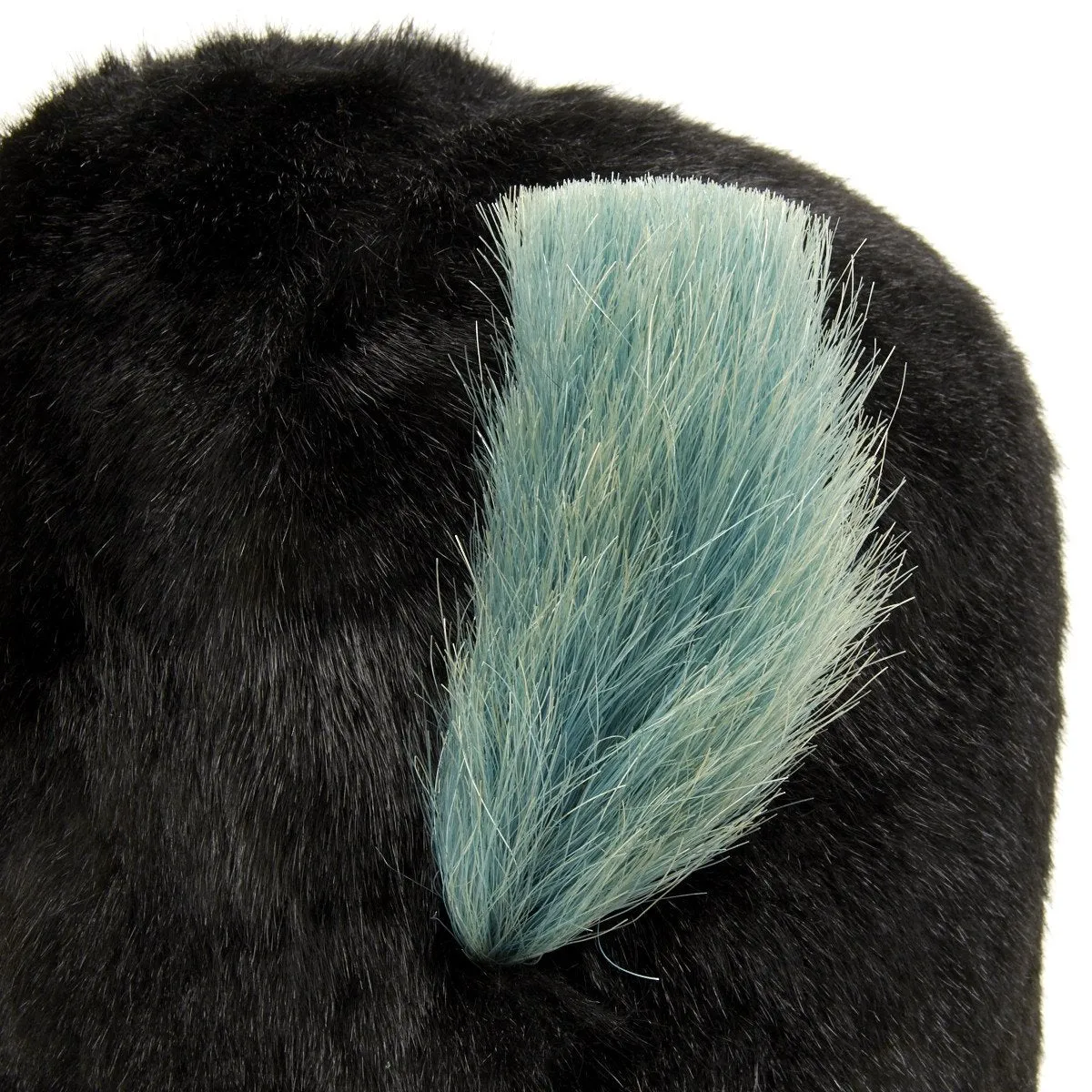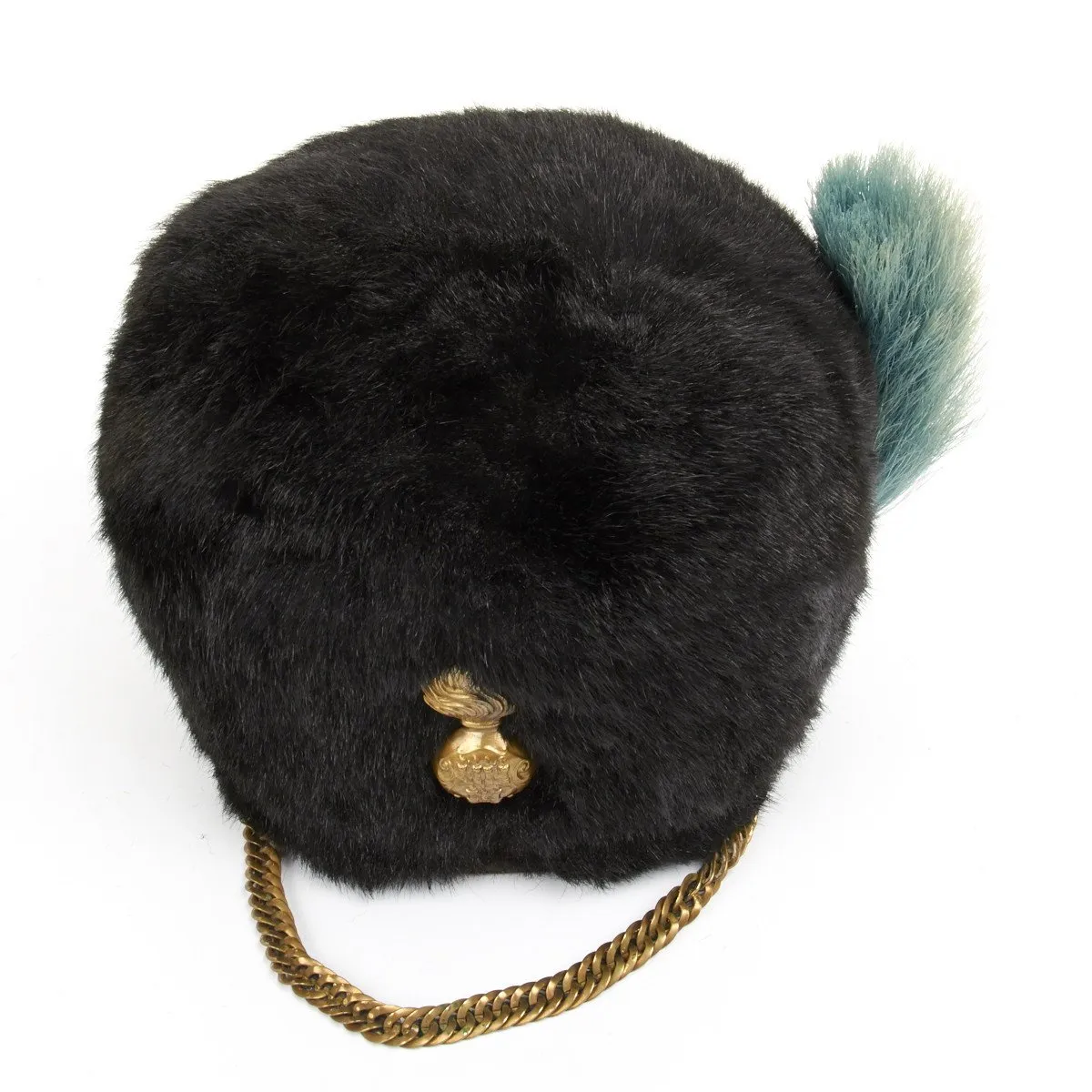Original Item: Only One Available. A fine example, still bearing the 1912 dated manufacturer's label that reads:
Size 6 7/8
This is an original short-haired bearskin Busby helmet of the legendary ROYAL DUBLIN FUSILIERS. It comes complete with original brass chained chinstrap, light blue horsehair plume and leather liner that shows wear from use.
History of the Royal Dublin Fusiliers
The Royal Dublin Fusiliers was an Irish infantry Regiment of the British Army created in 1881, one of eight Irish regiments raised and garrisoned in Ireland, with its home depot in Naas. The Regiment was created by the amalgamation of two British Army regiments in India - the Royal Bombay Fusiliers and Royal Madras Fusiliers - with Dublin and Kildare militia units as part of the Childers Reforms that created larger regiments and linked them with "Regimental Districts".
Both regular battalions of the Regiment fought in the Second Boer War. In the First World War, a further six battalions were raised and the regiment saw action on the Western Front, the Mediterranean, and the Middle East. In the course of the war three Victoria Cross were awarded.
Following the establishment of the independent Irish Free State in 1922, the five regiments that had their traditional recruiting grounds in the counties of the new state were disbanded.
First World War
The First World War began in August 1914, and the British Empire declared war on Germany after it invaded Belgium. The Regiment raised 6 battalions during the war (11 in total), serving on the Western Front, Gallipoli, Middle East and Salonika. The Dublin Fusiliers received 3 Victoria Crosses (VC), the highest award for bravery in the face of the enemy, and was also awarded 48 Battle Honors and 5 Theatre Honors. The Regiment lost just over 4,700 killed and thousands wounded during the war.
Western Front
The 2nd Dublins arrived in France in the month war was declared as part of 10th Brigade, 4th Division. The Division was part of the British Expeditionary Force (BEF), the professionals of the old regular army, known as the 'Old Contemptibles' after a comment made by the German Kaiser. The 2nd Dublins took part in the retreat following the Battle of Mons, taking part in their first engagement on 26 August 1914 at Le Cateau that helped delay the German advance towards Paris, inflicting such heavy casualties that the Germans thought they faced more machine-guns than they actually did. The BEF then resumed their retreat, but many men, including from the Dublin Fusiliers, were stranded behind German lines, and many were taken prisoner by the Germans. The Battalion, badly depleted, later took part in the Battle of the Marne (59 September) that finally halted the German advance just on the outskirts of Paris, forcing the Germans to retreat to the Aisne. There, the 2nd Dublins took part in the Battle of the Aisne and later took part in their last major engagement of the war, at the Battle of Armentières, which began on 13 October and ended on 2 November.
The 2nd Dublins took part in all but one of the subsidiary battles during Second Ypres that took place between 22 April 24 May 1915. The Battalion suffered heavily at the Battle of St Julien, the second subsidiary battle, incurring hundreds of casualties. They had no respite, taking part in the next two subsidiary battles at Frezenberg and Bellewaarde. On 24 May the Battalion was subject to a German poison gas attack near Saint-Julien and effectively disintegrated as a fighting unit. The British at that time had no defences against gas attack; indeed the large-scale use of gas by the Germans on the Western Front had begun at Second Ypres. The 2nd Dublins Commanding Officer, Lieutenant Colonel Arthur Loveband of Naas, died the following day. The Battalion did not take part in any more major battles for the rest of the year.
The 8th and 9th Dublins, who had arrived in France in December 1915 as part of 48th Brigade of the 16th (Irish) Division, were also subject to a German gas attack at the Battle of Hulluch, near Loos, on 27 April 1916, suffering heavy casualties. There had been trouble at home that month in Dublin when the Easter Rising had taken place though, in spite of this, the Dublin Fusiliers still performed with dedication to their duty. The British launched the Somme offensive on 1 July and the 1st and 2nd Dublins took part in the First Day of the Somme that saw the British forces sustain horrific casualties, some 60,000, about 20,000 of which were killed. The 8th and 9th Dublins took part in their first major battle during the Somme Offensive, taking part in the capture of Ginchy on 9 September. The Dublins also took part in the last major battle of the offensive, at the Ancre that took place between 1318 November. The Dublins, once again, had suffered large numbers of casualties during the Somme offensive.
In March 1917 the Germans retreated to the Hindenburg Line that was a formidable series of defences that the Germans had constructed. In April the British launched the Arras Offensive and the Dublin Fusiliers took part in the two battles of the Scarpe that took place in April. The 10th Dublins took part in the Battle of Arleux (2829 April) that saw the Dublins last involvement in a major battle of the Arras offensive. Half of the French Army, exhausted and angry at the enormous losses it had sustained, mutinied, refusing to fight unless it was to defend against German attacks. This compelled the British Army to take the leading role, and this would see the Dublin Fusiliers take part in further offensives before the year ended. In June, the Dublins took part in the capture of Wytschaete during the Battle of Messines. The Regiment's battalions subsequently took part in the Third Battle of Ypres (31 July 10 November), being involved in several of its subsidiary battles, including at Langemarck. As during Second Ypres, the Regiment suffered heavily, indeed the 9th Dublins had sustained such losses that they effectively ceased to be a fighting unit, and were amalgamated with the 8th Dublins in October, forming the 8th/9th Dublins. The Regiment's last major action of 1917 was a diversionary attack during the Battle of Cambrai (28 November 3 December).
In February 1918, due to the heavy losses that had been sustained, the 8th/9th and 10th Dublins were disbanded and its men were transferred to the 1st and 2nd Dublins. On 21 March the Regiment was on the defensive during the Battle of St. Quentin when the Germans began an immense bombardment as part of their last-gasp major offensive known as Operation Michael against British and Empire forces in the Picardy area. The 1st and 2nd Dublins suffered heavily from the intense bombardment (which included poison gas) and when the Germans attacked shortly afterwards, the Germans broke through the shattered remnants. The Germans made significant gains but their offensive gradually lost momentum and the Germans were pushed back by April. During that month, on the 14 April, the 1st and 2nd Dublins had to briefly amalgamate due to the losses it had sustained during the German offensive, forming the 1st/2nd Dublins. The 1st Battalion was reconstituted a few days later with drafts from the 2nd Battalion, which was reduced to cadre strength. On 26 April the 1st Dublins left the 16th (Irish) and rejoined the 86th Brigade, 29th Division. In June the 2nd Dublins transferred to the British 31st Division and was reconstituted. It was transferred to the Lines of Communication (LoC) before moving to British 50th Division in July. In August the Allies launched their counter-offensive against the Germans and eventually reached the Hindenburg Line. The Allies launched their offensive against the Line in September, and the 1st, 2nd, and 7th Dublins, took part in the battles of the St Quentin Canal, Cambrai and Beaurevoir, and the Hindenburg Line was successfully breached by the Allies. The Dublins took part in the last offensives of the war, taking part in, among others, the Fourth Battle of Ypres, Battle of Courtrai and the Battle of the Selle during September and October. The 1st Dublins lost their Commanding Officer, Lieutenant Colonel Athelstan Moore, on 14 October. The Regiment's last major battle was in the Battle of the Sambre on 4 November. The war ended on the Western Front with the Armistice on 11 November 1918.
Gallipoli, Salonika and the Middle East
The 1st, 6th and 7th Dublins all took part in the Allied Gallipoli campaign in the Dardanelles after Turkey joined the Central Powers in November 1914. It was an effort to support Russia by keeping the Dardanelles Strait open.
The 1st Dublins, as part of 86th Brigade of the 29th Division, landed at V Beach, Cape Helles on 25 April. The 1st Dublins were the first to land, landing via boats that were either towed or rowed, and suffered heavy casualties from a withering hail of machine-gun fire from the Turkish defenders, most not even getting out of their boats, while others drowned in the attempt, most due to the equipment they carried. The 1st Royal Munsters, two companies of the 2nd Royal Hampshires and a company of the 1st Dublins, landed from the SS River Clyde soon afterwards and were also decimated by machine-gun fire. In spite of the severe casualties, the British forces managed to land large numbers of troops by nightfall. On the morning of 26 April the British force, including the Dublins, took the fortress, led by Lieutenant Colonel Doughty-Wylie, before moving onto the village of Sedd-el-Bahr. Lieutenant-Colonel Doughty-Wylie and Captain Walford (who helped organise the attack) both died at the moment of victory. The 1st Battalion sustained just over 600 casualties within the first two days, out of a total of just over 1000 men that had landed. Nearly all of their officers, including Lieutenant Colonel Richard Alexander Rooth, had been killed on the day of the landings. The Battalion and the 1st Munsters had suffered so heavily that they had to form a composite battalion known as the 'Dubsters' on 30 April. Both battalions regained their identity the following month after they received a sufficient amount of replacements. During their time at Helles, the 1st Dublins took part in the numerous attempts to capture Krithia; the first attempt took place on 28 April.
The 6th and 7th Dublins joined the 30th Brigade of the 10th (Irish) Division upon their creation in August 1914. The division left Ireland for Basingstoke, England in May 1915. On 7 June the division left the UK under the command of Irish General Bryan Mahon, arriving in Lemnos by late July in preparation for the landings at Suvla Bay, Gallipoli. The Dublins landed at Suvla on 7 August; a day after the first landings there had taken place. Unlike at V Beach at Helles, Suvla was barely defended but incompetence at the higher echelons of command led to the British troops not exploiting their early advantage, ensuring that the Suvla landings became static and allowing the Turks to reinforce their defences. The Dublins took part in the effort to capture a position known as Chocolate Hill (78 August), which was successfully taken, though at a heavy cost. On 9 August the Dublins took part in the attempt to recapture Scimitar Hill, and managed to gain some ground but experienced ferocious resistance from the Turks that eventually forced the British to withdraw. The 1st Dublins and the rest of the 29th Division were moved to Suvla to reinforce the British force there. On 21 August the Dublins took part in another attempt to take Scimitar Hill and after the battle, the Suvla front-line became static, with no more major attacks being attempted. In September, the 6th and 7th Dublins and the rest of their division left Suvla, arriving in Mudros on Lemnos later that month.
On 1 January 1916, the 1st Dublins left Gallipoli for Egypt with the rest of the 29th Division and the last remaining British troops left Gallipoli on 9 January. The ironic thing was that the evacuation of Gallipoli by the Allies was, arguably, the most successful part of the campaign. The Dublins had suffered heavily, nearly all of the just over 1000 men of the 1st Dublins who had landed at Helles in April had been killed, wounded, experienced disease or were missing, but further carnage was to await them in France. The Dublin Fusiliers battalions that had seen service in Gallipoli had had a diverse composition, indeed D Company, 7th Dublins (known as the 'Dublin Pals' in much the same way as the Pals battalions) had a number of professional rugby players and most of the company had attended Trinity College, including Professor of Law Lieutenant Earnest Julian who was mortally wounded at Chocolate Hill and died on board a hospital ship, gaining the company the nickname 'The Toffs' which was in reference to the 2nd Dublins nickname, 'The Old Toughs'. Other companies were of a more humble background, from being miners and dockers to postmen, and many other roles in the community.
Meanwhile, the 6th and 7th Dublins had landed in Salonika in October 1915 as part of a British-French force requested by the Prime Minister of Greece, with the intention of assisting Serbia who had been invaded by Bulgaria, one of Germany's allies during the Macedonian campaign. By the time the British-French force had arrived, Serbia had been defeated but the Allies remained. The Dublins took part in the Battle of Kosturino (78 December) and in the British withdrawal from Serbia. After Kosturino, things were mostly quiet, though the British still suffered casualties from disease, such as dysentery and malaria, and also suffered from frostbite. In October 1916 the Dublins took part in the capture of the village of Yenikoi where they suffered heavy casualties, including friendly fire from their own artillery. In August 1917 the 6th and 7th, along with the rest of the 10th (Irish), were ordered to concentrate in Salonika in preparation for moving from the Balkans. The following month the division arrived in Egypt and then commenced their participation in the Palestine campaign. The campaign was a much more successful one than the previous two campaigns that the Regiment had experienced and the Dublins took part in the Third Battle of Gaza (27 October 7 November). The Dublins also took part in the capture of Jerusalem and in its subsequent defence from Ottoman counter-attack. The 7th Dublins left the division, moving to France in April 1918 and was attached to the 16th (Irish) on 10 June. It was, however, absorbed by 11th Royal Irish Fusiliers only 8 days later. The 6th Dublins followed the 7th the following month, also heading for France. It joined the 66th Division in July.
1916 Easter Rising
Three Battalions of the Royal Dublin Fusiliers attacked rebels in the Easter Rising of 1916 in Dublin. 11 of the Royal Dublin Fusiliers were killed and 35 more wounded. John Dillon an Irish MP who was in Dublin during the Easter Rising told the House of Commons "I asked Sir John Maxwell himself, Have you any cause of complaint of the Dublins [Royal Dublin Fusiliers]'who had to go down and fight their own people in the streets of Dublin? Did a single man turn back and betray the uniform he wears? He told me, Not a man." At the court martial of Seán Heuston two Royal Dublin Fusiliers officers, Captain A W MacDermot and Lieutenant W P Connolly give evidence against Heuston that resulted in him being executed by firing squad on 8 May 1916.
Guinness brewery killings
On the night of 29 April 1916, a picket of the 5th Battalion, Royal Dublin Fusiliers stationed within the Guinness Brewery arrested and then shot dead William John Rice and Algernon Lucas. The same night, in a separate incident, Cecil Dockeray, and Basil Worsley-Warswick were shot. 2nd Lt Lucas and 2nd Lt Worsley-Warswick were officers in the King Edward's Horse, Rice and Dockeray were employees at the brewery. The four men were killed while carrying out routine inspections of the premises. CQMS Robert Flood, commander of the picket and who ordered the executions was court-martialled, charged with the murders of Rice and Lucas but was acquitted, claiming in his defence that he believed the four to be members of Sinn Féin and that his picket was too small to guard the four prisoners.
Disbandment
All the war-raised battalions were disbanded either during the war, or shortly afterwards. The 1st Dublins crossed the German border in early December; no doubt nearly all that had been with the Battalion when it first entered the war in Gallipoli were long dead. The Battalion eventually reached Cologne where the British Army of Occupation in Germany was based. The Battalion returned to the UK a short while afterwards, based in Bordon. The 2nd Dublins left war-ravaged Europe to join the Allied Army of Occupation in Constantinople, Turkey and in late 1920 moved to Multan, India, before returning to the UK in 1922.
Due to substantial defense cuts, and the establishment of the Irish Free State (the predecessor of the Republic of Ireland) in 1922, it was agreed that the six former Southern Ireland regiments would be disbanded, including the Royal Dublin Fusiliers. On 12 June, five regimental Colours were laid up in a ceremony at St George's Hall, Windsor Castle in the presence of HM King George V. (The South Irish Horse who sent a Regimental engraving because the regiment chose to have its standard remain in St. Patrick's Cathedral, Dublin). The Dublin Fusiliers detachment included the commanding officers of the 1st Dublins and 2nd Dublins, lieutenant-colonels C. N. Perreau and G. S. Higgingson, who had been captured in France during the first year of World War I, and the regiment's Colonel-in-Chief, HRH the Duke of Connaught. The Colours remain there as of 2005. The six regiments were all disbanded on 31 July 1922. With the outbreak of the Irish Civil War conflict some thousands of their ex-servicemen and officers contributed to expanding the Free State government's newly formed National Army. They brought considerable combat experience with them and by May 1923 comprised 50 per cent of its 53,000 soldiers and 20 per cent of its officers.
On 27 April 2001, the Irish government officially acknowledged the role of the soldiers of the Royal Dublin Fusiliers who fought in the First World War by hosting a State Reception at Dublin Castle for the Royal Dublin Fusiliers Association.






